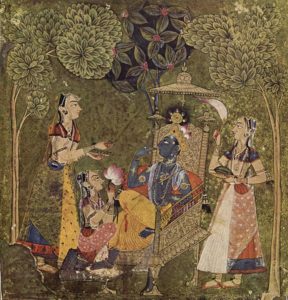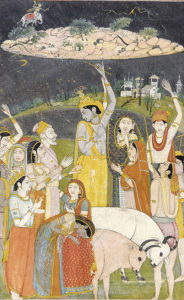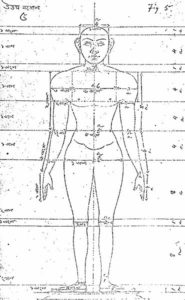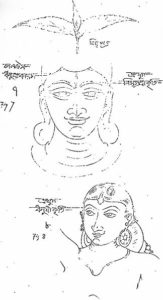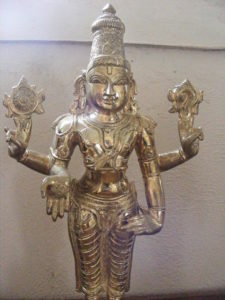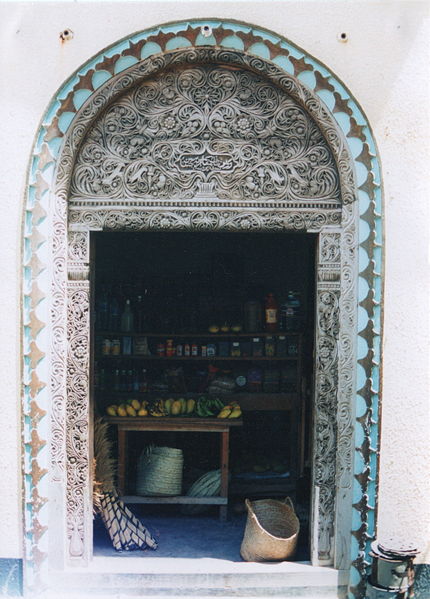Today’s blog post will take us to India भारत Bharat, and to Indian art, कला kala, and aesthetic theory.
Indian art is based on the ancient aesthetic theory of rasa रस (Sanskrit lit. ‘juice’, ‘extract of a fruit’ or ‘essence’) which, by extension, refers to the finest quality of an object. The term rasa रस generally refers to the ‘essence’ and emotional qualities crafted into a work of art (or a performance) by the maker and to the response the contemplation or perception of the artwork evokes in the viewer, or sahṛdaya सह्रदय. So it is a viewer-response theory. Rasas are created by bhavas भव (or states of mind). The concept of rasa has its origins in performance theory. Emphasis is therefore always on the spectator, and the artwork or performer only serves as a means for the viewer to experience the different rasas. That is the reason why in Indian paintings and sculpture a narrative mode predominates: a narrative gradually unfolds over the area of a painting or the length of a wall or even building.
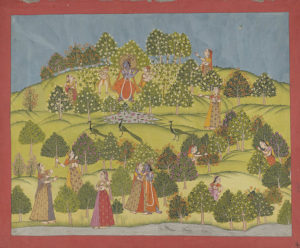
Author: Bodleian Library Oxford; Krishna (with blue complexion and yellow garments) moves through the painting, thereby telling a narrative
The concept of rasa is fundamental to many forms of Indian art, and can be found in dance and performance, music, musical theatre, literature as well as cinema.
The Rasas were first described by Bharata Muni भरत मुनी, an ancient Indian musicologist and theatrologist, in the Nāṭya Śāstra (Sanskrit: नाट्य शास्त्र, Nāṭyaśāstra), a Sanskrit Hindu text on dramatic theory and the performing arts, written between 200 BCE and 200 CE. According to this text, there are 8 original rasas, each of which has an associated deity and a specific colour. Later authors have added a 9th rasa, plus some additional rasas.
- Shringaram (शृङ्गारं) Love, attractiveness, erotic. Deity: Vishnu. Colour: green; the erotic rasa is blue-black. Considered the ‘king of rasas‘.
- Hasyam (हास्यं) Laughter, mirth, comedy, comic. Deity: Ganesha. Colour: white.
- Raudram (रौद्रं) Fury. Deity: Rudra. Colour: red.
- Kāruṇyam (कारुण्यं) Compassion, tragedy, pathetic. Deity: Yama. Colour: dove-coloured (grey-white).
- Bībhatasam (बीभत्सं) Disgust, aversion, abhorrent, shocking, odious. Deity: Shiva. Colour: blue
- Bhayānakam (भयानकं) Horror, terror, fear, terrible. Deity: Kala. Colour: black
- Vīram (वीरं) Heroic mood. Deity: Indra. Colour: wheatish brown (yellow, ochre)
- Adbhutam (अद्भुतं) Wonder, amazement, wonderful, wondrous. Deity: Brahma. Colour: yellow
- The 9th rasa is Śāntam (शांता) Peace or tranquility, quiescent. Deity: Vishnu. Colour: perpetual white (silvery, the colour of the moon and of jasmine)
The 9th Shanta-rasa is simultaneously seen as an equal member of the rasas, but also as distinct, since it represents the clearest form of aesthetic bliss and has been described as “as-good-as but never-equal-to the bliss of Self-realization experienced by yogis”.
In Indian art, the rasas become apparent, for example in the colour in which a certain deity is depicted which hints at the predominant character trait associated with this deity, or in the colour of the aura of a person. For instance, a black aura indicates a frightened person, and a red aura indicates that the character is angry. The god Krishna, who is the archetypal lover and hero, is always depicted with a blue-black complexion and yellow garments.
Two additional rasas appeared later on, in particular in Indian literature. These are:
- Vātsalya (वात्सल्य) Parental Love
- Bhakti (भक्ति) Spiritual Devotion
However, a specific deity or colour has not been assigned to these two rasas.
Another important term in Indian art is Murti (Sanskrit: मूर्ति Mūrti) which usually refers to any solid object that has a definite shape and is made from material elements like wood, stone, pottery or metal. The term murti basically refers to any statue, or to an image or idol of a deity or person, as well as to any incarnation, embodiment, manifestation and appearance of a deity. Murti constrasts with the immaterial world of mind and thought of ancient Indian literature.
Medieval Hindu texts like the Puranas (Sanskrit: पुराण, purāṇa, lit. ‘ancient’, ‘old’), the Agamas (Sanskrit: आगम, lit.’tradition’, from the verb root गम gam meaning ‘to go’ and the preposition आ aa meaning ‘toward’ -> ‘that which has come down’) and the Samhitas (Sanskrit: संहिता, saṁhitā, lit. ‘put together, joined, union’) described the proper proportions, positions and gestures (mudra) for the murti.
The expressions in a Murti vary, but there are two major categories in Hindu iconography:
- Raudra रौद्र (lit. dire) or Ugra उग्र (lit. fierce, violent, furious) symbolism – used to express fear, violence and destruction (deities: Kali, Durga). Typical elements include adornment with skulls and bones, weapons, and wide, circular eyes. Raudra deity temples were invariably located outside of villages or towns, and in remote areas of a kingdom. Ugra images were worshipped by soldiers before going to war, or by people in times of distress.
- Shanta शांता (lit. peaceful) and Saumya सौम्या (lit. gentle, benign, kind) symbolism – used to express joy, love, compassion, kindness, knowledge, harmony and peace (deities: Lakshmi, Saraswati). These temples were predominantly located inside towns and villages. Saumya images symbolize peace, sensuality, knowledge, music, wealth, flowers, etc.
Apart from anthropomorphic murti, some Hindu traditions prefer aniconism, that is the absence of figurative representations of the natural or supernatural world. Here the murti take the shape of the linga for Shiva, the yoni for Devi, and the shaligrama for Vishnu.
A murti may be found inside or outside homes as well as temples, and in some cases it can just be a landmark. A murti is often considered as an embodiment of the divine or Brahman, and may be treated as a welcome guest in homes and serve as a participant in Puja rituals.
The artist, कलाकार kalakar, or artisan who makes any works of art or crafts, including murti, is known as Shilpin शिल्पिन्, (for a male artist) or Shilpini शिल्पिनी (for a female artist). The Shilpins design the murti according to the rules of canonical manuals like the Agamas and the Shilpa Shastras. The term Shilpa Shastras (Sanskrit: शिल्प शास्त्र śilpa śāstra) literally means the Science or Discipline of the Shilpa (i.e. the arts and crafts). Shilpa शिल्प refers to any art or craft, while Shastra शास्त्र means ‘iconography’, ‘a work of scripture’ or ‘discipline’. Man-made works of art are termed Shilpani शिल्पनि. The Shilpa Shastra is an umbrella term for various Hindu treatises and manuals on the arts and crafts, which outline Hindu iconography, design principles and rules, composition, the ideal proportions for human sculptures, as well as the principles and rules of architecture.
The Brihat Samhita बृहत् संहिता (lit. ‘Large Codex’), a 6th-century encyclopedia covering a wide range of topics from astrology to horticulture to murti and temple design, and the 6th-century treatise Manasara-Shilpashastra मनसारा शिल्पशास्त्र (literally: ‘treatise on art using the method of measurement’), specify 9 materials that can be used for the creation of murti: stone पत्थर patthar, wood लकड़ी lakadee, copper तांबा taamba, gold सोना sona, silver चांदी chaandee, earth (= clay मिट्टी mittee or terracotta टेरकोटा), sudha सुधा (a type of mortar plaster or stucco), sarkara सरकार (gravel, grit), and abhasa आभास (various types of marble or stones, which have a range of colours and opacity). Metal murti are often made from a special alloy called panchaloha, which is believed to have auspicious properties and is considered of sacred significance. Panchaloha (Sanskrit: पञ्चलोह), which is also known as Panchadhatu (Sanskrit: पञ्चधातु, lit. ‘five metals’), is an alloy consisting of 5 metals, namely gold (Au), silver (Ag), copper (Cu) iron (Fe) and lead (Pb); the lead is often replaced by tin (Sn) or zinc (Zn).
References: Indian Art, by Vidya Dehejia, Phaidon Press, London, 1997
https://en.wikipedia.org/wiki/Indian_aesthetics
https://en.wikipedia.org/wiki/Shilpa_Shastras
https://en.wikipedia.org/wiki/Murti

